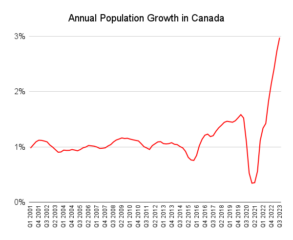
October 18, 2023

Source: Bigstock
Canada is currently subjecting itself to a bizarre experiment in extreme population growth due to pedal-to-the-metal legal immigration.
Canada’s population rose about 1 percent per year for the first decade and a half of this century. But the Justin Trudeau era began in 2015, and growth was goosed to 1.5 percent by 2019. After a brief pandemic pause, the Trudeau government is now opening the borders extraordinarily wide.
In response, Canada’s annual population growth rate hit 3.0 percent in the third quarter of 2023, the kind of rise normally associated with Bangladesh in the 1980s. Over the summer, Canada’s population reached 40 million, up from 30 million in 1997.

The number of nonpermanent residents was allowed to soar by almost 700,000 in the past twelve months. There are now 46 percent more foreigners in Canada temporarily, mostly on work and study permits, than one year ago, the largest annual increase in the half century for which the Canadian government has data.
Granted, some of these recent arrivals are Ukrainian women refugees, but the government’s target is 465,000 permanent immigrants this year rising to 500,000 in 2025, about 1.2 percent of the population annually, four times the rate at which the United States lets in immigrants.
It’s a big world out there, and billions of people live in countries that their kin have helped make lousier than Canada. So there’s no end to how many immigrants Canada can recruit. (At least until Canada’s standard of living converges with its source countries like Pakistan.)
The official Statistics Canada government agency projected in 2022:
…the Canadian population would reach 47.7 million in 2041, and 25.0 million of them would be immigrants or children of immigrants born in Canada, accounting for 52.4% of the total population…. Canada’s population may reach…between 44.9 million and 74.0 million in 2068, according to the various projection scenarios.
Back in 1996, less than 6 percent of Canada’s population were minorities. But according to the government:
In 2041, about 2 in 5 Canadians will be part of a racialized group.
To digress briefly, if you are wondering what’s the point of the euphemism “racialized” for nonwhites, this is another Canadian innovation in woke jargon, like “BIPOC.” The idea is, apparently, that, because all good people know that Race Does Not Exist Genetically, but on the other hand, the government is obsessed with counting by race, the Canadians have squared that verbal circle. They’ve decided that while nonwhites aren’t nonwhite racially, because race doesn’t exist, they are thought to be “nonwhite” because they’ve been racialized by whites, whose lying eyes tell them that the racialized look like they might have different ancestors than they do.
Or something.
A lengthy article in The Washington Post this week demanding that the American Census Bureau stop asking “What race are you?” and start asking “How are you racialized?” explains the logic, such as it is: “Race isn’t real, science says. Advocates want the census to reflect that.”
Well, all this immigration at least means Canada will be reinvigorated by its teeming youthful newcomers, right?
Wrong. The Canadian statistics office notes:
However, immigration is unable to significantly increase the proportion of youth in the population.
Immigrants aren’t zero-year-old babies; they are, typically, grown-ups, often the elderly relatives of previous immigrants.
Canada will therefore need to remain addicted to its immigration fix forever, according to the government population experts:
This means that Canada will remain dependent on high immigration levels to renew its population, particularly in the context of a low and recently declining fertility rate.
But is massive immigration itself helping drive Canada’s declining fertility rate? During Trudeau’s first seven years in office, the total fertility rate (how many babies the average woman is expected to have per lifetime) dropped from 1.60 in 2015 to 1.33 in 2022. Statistics Canada warned in 2022:
If the country’s fertility continues to decline further in the coming years, Canada could join the countries with the “lowest-low” fertility rates (1.3 or less children per woman)—a situation associated with rapid population aging and increased stress on the labour market, public health care and pension systems.
The most obvious way immigration is depressing native Canadian fertility is by making family formation unaffordable. America’s housing costs relative to wages are ridiculous, but Canada’s are significantly worse.
You might ask why a house with a yard costs so much in vast Canada. Doesn’t Canada have immense amounts of prairie and tundra? Sure, but immigrants from the warm Global South don’t want to live in the middle of frigid nowhere; they want to be in a big, rich metropolitan area like Toronto or, ideally, Vancouver.
But Toronto’s suburban expansion is hemmed in by Lake Ontario, so it can only expand 180 degrees. And in fact, most people want to live near the lake with its moderating effect on the temperature, so expansion is even more constrained than you’d imagine.
Basically, there’s one beautiful big city in Canada with a decent climate. But Vancouver is hemmed in by the ocean and by immense mountains. Good luck for an average person born in Canada being able to ever afford to move to Vancouver these days.
Not surprisingly, in the most desirable piece of Canadian real estate, British Columbia, the total fertility rate is down to 1.11.
English-speaking white Canadians are famously polite, but even they are starting to gripe. Abacus Data did a survey in June finding that immigration is finally becoming a controversial policy in Anglophone Canada (Quebec is privileged to have its own more restrictive immigration laws to protect French dominance):
I can’t remember the last time immigration featured prominently in national political debates in Canada…. The lack of friction on the issue, in my view, is more likely the result of an elite-consensus on the value of immigration than a reflection of public opinion….
61% believe that Canada’s target to welcome 500,000 immigrants next year is too high, including 37% who feel it is “way too high.”
When asked whether the number of immigrants coming to Canada is having a positive or negative impact on several possible areas, 63% feel it is having a negative impact on housing, 49% feel this way about its impact on traffic and congestion, and 49% feel immigration is having a negative impact on healthcare.
Finally, how is massive population growth via immigration compatible with Trudeau’s vaunted crusade to fight climate change by cutting carbon emissions?
In India, the most important source country for migrants to Canada, the average person is responsible for 2.3 tons of carbon dioxide equivalents annually. In Canada, the average resident accounts for 17.8 tons of greenhouse gases. That’s 7.7 times as much. So turning a resident of India into a resident of Canada puts a strain on the global climate.
People in Canada emit even more carbon per capita than Americans do. They drive a lot. It’s too cold in winter to stand around waiting for the bus.
Migrants move to Canada in the hope of being able to afford that auto-centric lifestyle. That’s the whole point of immigrating to Canada. Nobody in the rest of the world cares about Canada’s historic propositions, if it has any. Its appeal is that living in Canada is the closest thing to living large in America. As Homer Simpson pointed out, to the rest of the world, Canada is America, Jr.